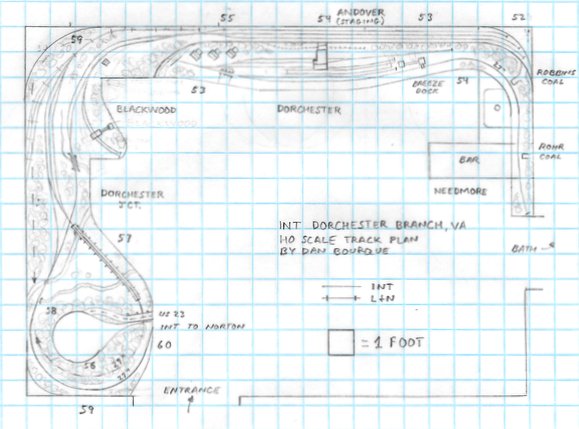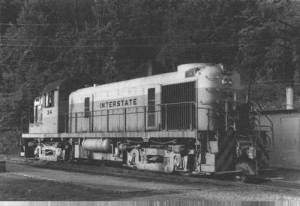- Size: 20′ x 15′
- Scale: HO
- Minimum Mainline Radius: 27″
- Minimum Aisle Width: N/A″
- Designed by Dan Bourque
![]() The Interstate Railroad had four primary branch lines that served the coal fields of southwestern Virginia. The shortest of those branches was the Dorchester Branch which split from the L&N and crossed the Interstate mainline at Dorchester Jct., VA. Its profile crossed a valley via a trestle before descending and then ascending a grade to Dorchester, home of a medium-sized tipple and two banks of coke ovens along with a couple small truck-dump docks at the end of the line. What made Dorchester tricky for crews was everything was stub ended, and trains had to be shoved from Dorchester Jct. to the tipple. For a while, the Wise Coal and Coke Company did switching with its own steam locomotive long after the Interstate had dieselized, making this an interesting place to model.
The Interstate Railroad had four primary branch lines that served the coal fields of southwestern Virginia. The shortest of those branches was the Dorchester Branch which split from the L&N and crossed the Interstate mainline at Dorchester Jct., VA. Its profile crossed a valley via a trestle before descending and then ascending a grade to Dorchester, home of a medium-sized tipple and two banks of coke ovens along with a couple small truck-dump docks at the end of the line. What made Dorchester tricky for crews was everything was stub ended, and trains had to be shoved from Dorchester Jct. to the tipple. For a while, the Wise Coal and Coke Company did switching with its own steam locomotive long after the Interstate had dieselized, making this an interesting place to model.
The Layout
This layout captures the entire Dorchester Branch and all its tracks and loaders. For extra operation, I’ve included the siding at Blackwood (a couple miles further east) and its loader. This is not my first track plan for Dorchester, but this one is designed for a slightly larger space (my basement) where the room must be shared, necessitating the L-shaped design. One of the things I focused on in this design is the orientation of scenes–I needed the coke ovens in front of the tipple (and hillside in back), AND I wanted to feature the trestle while still being able to work the side tracks alongside the L&N at Dorchester Jct. To get this, I had to use a dogbone and loop of hidden track to flip the orientation, but this turned out to be a good feature as it increases the running distance up the branch in addition to correct orientation of the scenes. A portion of the Interstate main toward Norton, VA is modeled because trains needed this section of the main to get their trains off the branch and oriented back toward Andover (staging).
Staging for this track plan is problematic because the staging tracks are above the level of the branch. My idea is to hide the staging tracks with a low backdrop of painted hills in front of the tracks and a tall backdrop with sky (and more painted hills) behind the staging tracks–not ideal, but workable. Benchwork would be straightforward with either L-girder or box suspended from the walls with occasional legs to keep things from sagging. Because only a handful of locomotives would be used, even an entry DCC system would be sufficient provided it allows for walk-around operation.
Operations
Operations on this layout are trickier than you might think. Based on experience with a smaller version of this arrangement on my old layout, it would take 1-2 operators more than an hour to make all the moves required, mainly due to the stub tracks at Dorchester and the odd way of entering the branch from the Interstate main (no direct access). Luckily, the moves required are all well documented in Ed Wolfe’s great book Appalachian Coal Hauler! During the steam era, the Dorchester Crew would start in Andover (staging) and make their way to Dorchester Jct. where they would back their train toward the L&N (where the “59” is in the track plan). Then, they would clear the locomotive (usually a 2-8-0) out of the way, line the switches, and ROLL the empty hoppers across the diamond and onto the trestle. From there, the crew would shove toward Dorchester, setting the empties on the main and clearing the loads from under the tipple and coke tracks, then placing the empties above the tipple and where needed on the coke tracks. In the late ’40s when the three docks were constructed on the branch above the tipple, extra work was required to gather those loads and place empties all on the single track. Once the loads were gathered, they were taken a handful at a time back to Dorchester Jct., two or three trips were needed to get up “powerhouse hill” between Dorchester and the trestle. Once reassembled, the train would be pulled onto the L&N until clear of the switch back toward the Interstate main, then the crew would let the train go and shove it up the steep main toward Norton until clear of the mainline switch, then it was clear sailing back to Andover.
This operation can be modeled step for step on this layout, though the “rolling across the diamonds” would require some kind of smooth braking mechanism. As a substitute, the side tracks between the diamond and the L&N could be used to run around the train. To add to the operation, hoppers would need to be blocked to separate cars moving the Southern (Andover), the N&W or Clinchfield (Norton) and the L&N (Dorchester Jct.)–all but the Southern cars could be dropped off in the side tracks at Dorchester Jct. Blackwood could either be worked by the Dorchester crew or by a second crew (simulating the end of their run before returning to Andover). Variety can also be added by era. The steam era has already been covered, but in 1954, shortly after the Interstate dieselized, the Wise Coal and Coke Company purchased old Interstate 2-8-0 No 5 to switch the tipple and coke operations of Dorchester. The Interstate mine run (now known as the Norton Switcher) would simply shove the empties onto an open track, grab the loads nicely lined up on the main, and return to Dorchester Jct. The 2-8-0 would then take over switching duties, a real chore when hoppers had to be spotted at very specific spots for coke loading. Dorchester shut down in the early ’60s and was reopened (minus the coke ovens) with a smaller tipple in the late ’60s after the Southern had taken over. It operated until the ’80s with Southern F-units serving as mine run power until ’69, GP38s in the early ’70s, and a mix of GP38s, 30s and 35s in the late ’70s. Despite the late era, hoppers were usually old twin cars used for shuttle service to the huge transloader in Appalachia, near Andover.
Things I Like About this Plan:
- Allows very prototypical operations
- Key scenes (e.g., trestle) modeled to near scale size
- Variety in operations based on era
Things I Don’t Like About this Plan:
- Staging up high and tough to access
- Good bit of hidden track for layout size
- Some switches difficult to reach
Related Products:






Had I only the right room arrangement, Dan! That aside, this is great trackplan that captures the essence of the Dorchester Branch in appearance and operation.